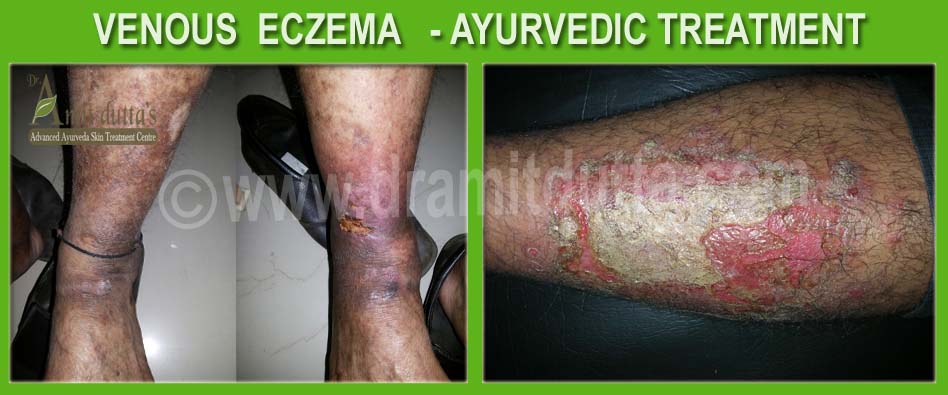Venous Eczema
Venous Eczema or Venous Dermatitis is an itchy rash occurs on the lower legs. This dermatitis arises when there is a venous disease. It is also known as “Gravitional eczema “ or “Stasis Eczema”.
Often this is reverse of flow in the veins causes the vein to dilate (Varicose veins) but very often the veins do not dilate or are not seen as in venous incompetence or hidden varicose veins. Normally during walking the leg muscles pumps the blood upwards and the valves in the veins prevent pooling. A clot in the deep leg vein (DVT- Deep Vein Thrombosis ) or varicose veins may damage the valves, as a result back pressure develops and fluid collects in the tissues.
The affected leg is swollen in venous disease , particulary after prolonged standing and during hot weather. Swelling is due to inflammation and pressure from build up of blood in veins with damaged valves. Dermatitis may arise as discrete patches or affect the leg all the way around. The affected skin is red and scaly and may ooze crust and crack. It is frequently itchy.
SIGNS AND SYMPTOMS
Venous eczema is usually found in the lower legs. Patches of venous eczema are usually on the inner aspects of the lower legs, just below the calf but above at the ankle.
These patches of venous eczema are usually red , but some times if the eczema has been there for long time , the skin may becomes flaky if it has been scrached. The patches are usually a few cm in diameter but can be smaller or larger depending on the underlying venous condition. Occasionally venous eczema can be seen higher up the leg , even around the knee or lower thigh.
The true venous eczema will be restricted to the legs only . if there is eczema elsewhere on the arms or body , then any eczema found on the legs is less likely to be venous.
CAUSES OF VENOUS ECZEMA
The underlying venous refulx are causing inflammation in the skin capillaries, which causes the skin to react and venous eczema is formed. In normal leg veins, valves keep the bloof flowing upwards on movement and prevent it falling back down the legs when standing still. In patients with venous disease the valves have stopped working and the blood falls backwards down the veins called venous reflux. As the blood falls back from the heart and down the veins , it hits the capillaries at the ankle causing them to inflamed. This is only a very small inflammation and when it happens first it hardly do any affect. When the constant inflammation every time the person stands up starts to have an effect and the capillaries start getting thickened and the surrounding tissue becomes inflamed. Over the time this inflammation spreads through the tissues of the lower legs making the subcutaneous fats hard and swollen and then the skin becomes red and itchy. This is the venous eczema.
AYURVEDIC TREATMENT FOR VENOUS ECZEMA
Graduated compression stockings , when fitted correctly , reduces the impact of blood refluxing down the vein, reducing the inflammation of the skin and flesh around the ankles. Therefore if the graduated prseeure stockings are put on as soon as the patient gets out of bed in the morning and worn whenever the patient is standing up they reduce the impact of the venous reflux back down the veins which reduces the inflammation and allows the venous eczema to start heal.
Ayurveda provides authentic treatment for Venous Eczema
- Oral Mixtures of Herbs and Herbo-Mineral Medicines.
- Pancha-Karma Detoxification Therapies
Proper Internal and External Oleation and fomentation followed by Virechana and Sansarjan Karma .
- Blood Letting – Rakt Mokshana via Leech in some cases.
- The washing of the lesions by the proper made Qwatha from the herbs that kill the organisms that causes the disease and maintains the proper hygiene.
- A Paste of Herbal Medicines is applied deep into the lesions that check the growth of the disease causing organisms. It fastens the healing of the ulcers.
- Anti septic dressing with medicated oils and creams made of – Nimba Taila , Karanj oil , Jatyaide oil , Apamarg kshar oil.
- Oral medications which are useful in all types of ulcers are Dashmoolarishta , Khadirarishta , Haridra , Tulsi leaves , Panchtikt ghrit guggulu , Kanchanaar Guggulu , Mahamanjishtaide qwath , Panchatikta ghrit guggulu for local application also , Kaishore guggulu. Ashwgandha , Swarn makhika bhasma , Vaikrant bhasma , Abhrak bhasma are useful in skin ulcers

